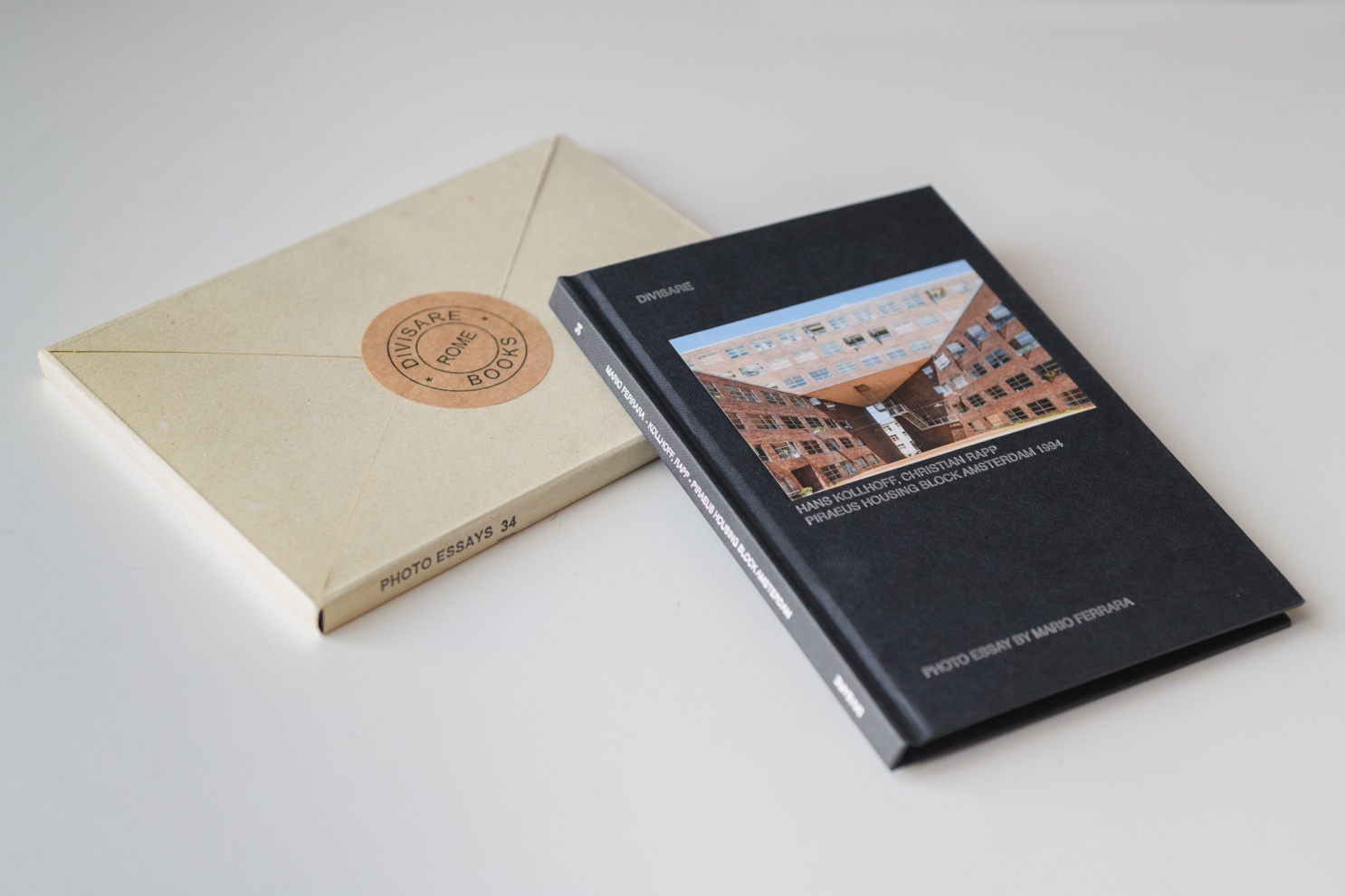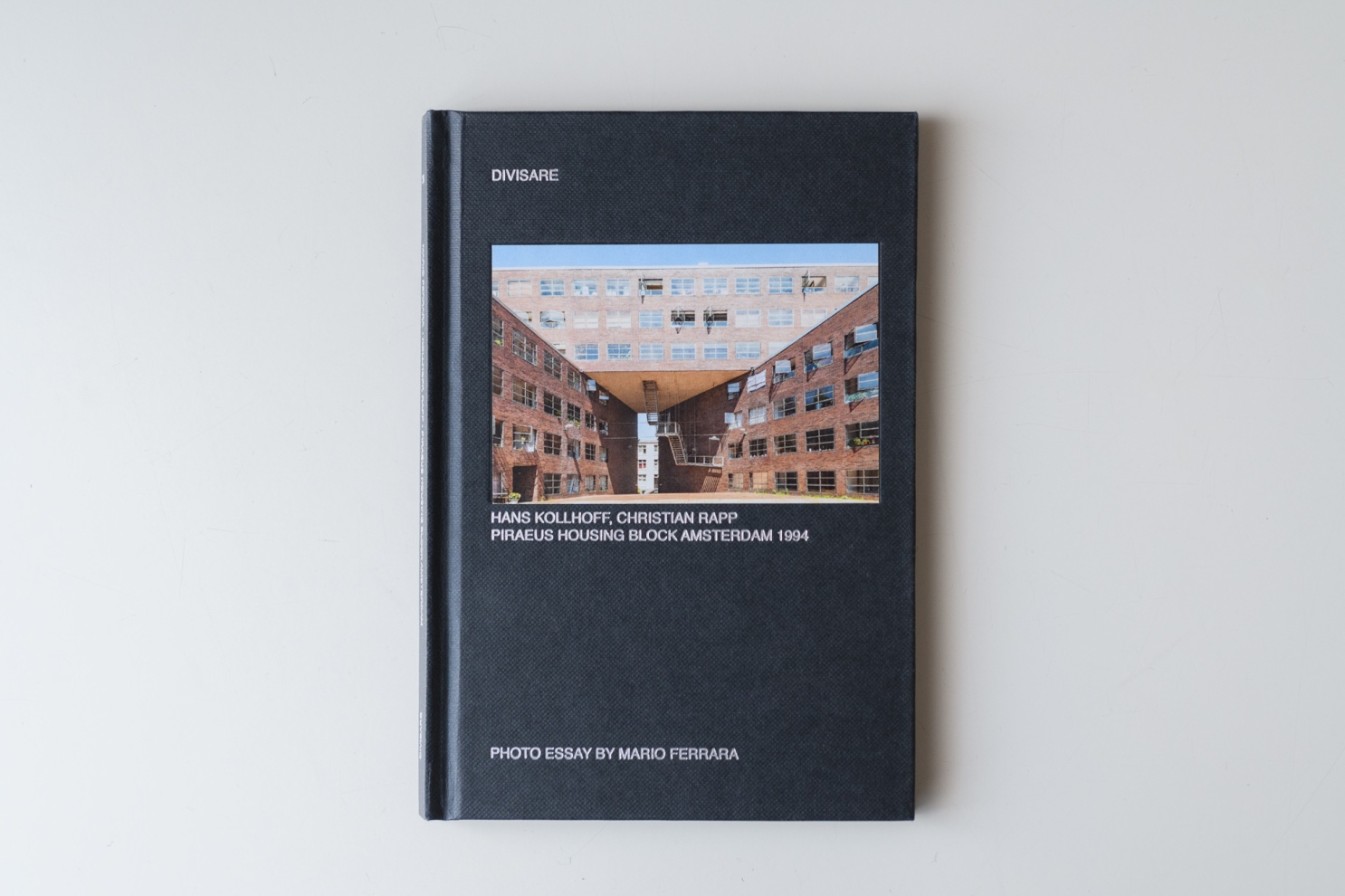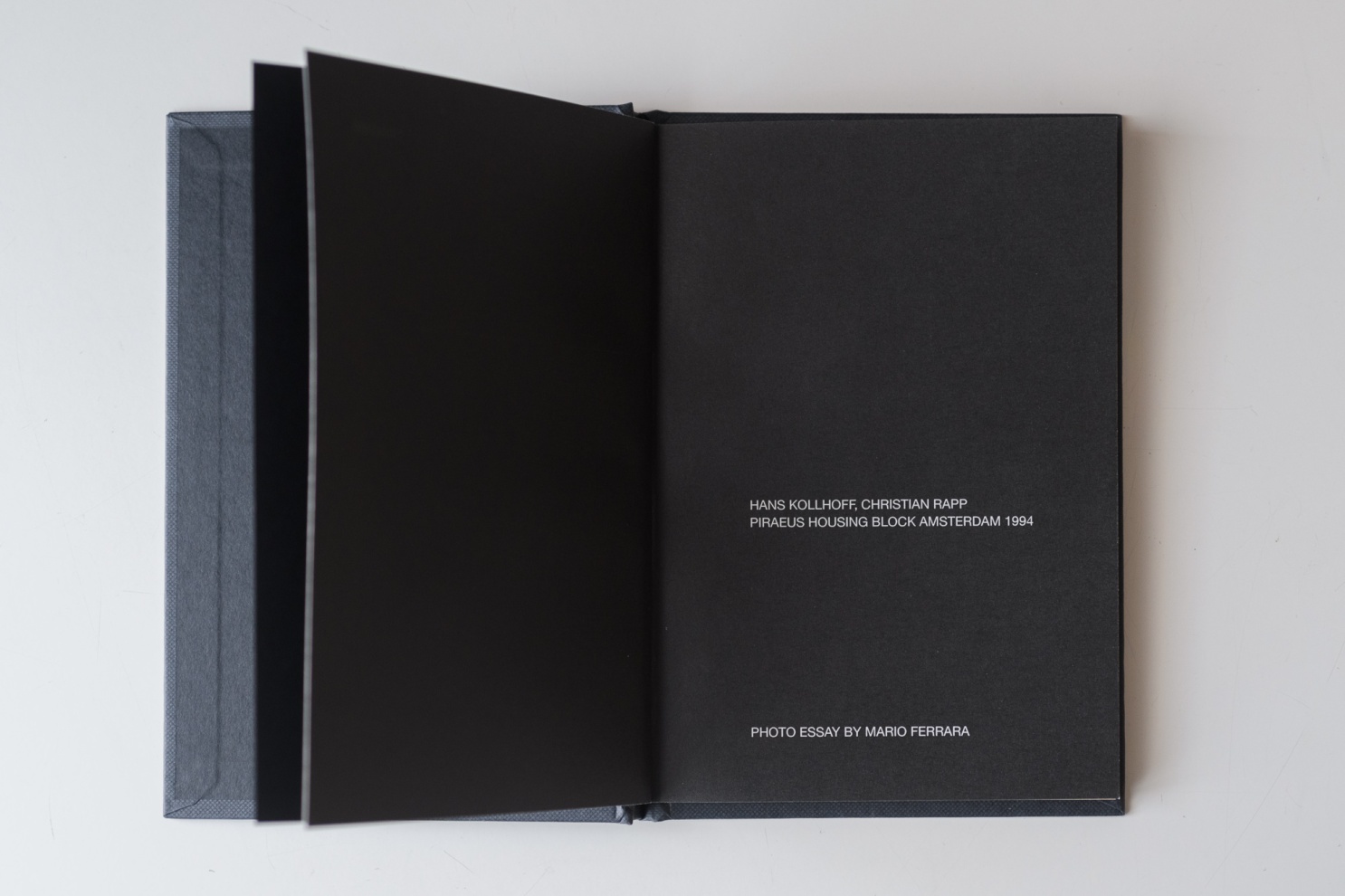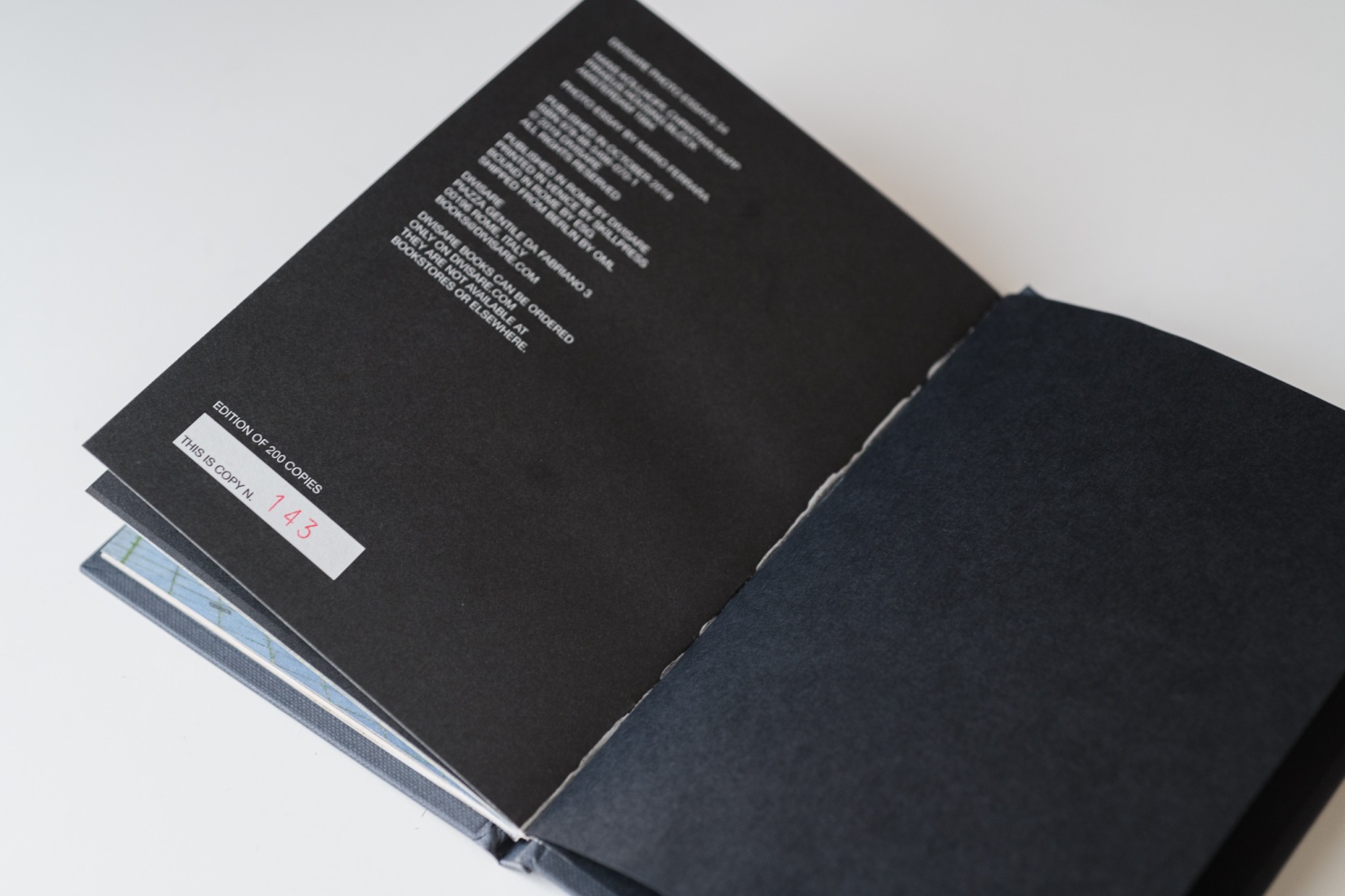photo essay by Mario Ferrara
Editore / Publisher
DIVISARE BOOKS
Acquista / Buy
DIVISARE BOOKS online store
Edition: 200 copies
Publication: february 2020
Printing: high-resolution digital printed
Binding: bund with refe thread
Photographs: Mario Ferrara
Size: 12,5 cm x 17,3 cm
Pages: 40
ISBN: 9788854960701
Cover: hardcover finished in fine english paper with title in silver foil hot stamped
Ita
Lo sguardo, la pietra, gli uomini: l’Housing Block “Piraeus” di Amsterdam (H. Kollhoff, C. Rapp, 1989-1994) interpretato da Mario Ferrara
Il lavoro che Mario Ferrara ha condotto su questa opera di Kollhoff e Rapp ad Amsterdam è l’esito dell’incontro tra un artista e un’opera firmata da maestri dell’architettura del nostro tempo. Più precisamente: è un racconto, nella forma di un percorso di conoscenza, attraverso un progressivo “avvicinamento” all’architettura. Un percorso che osserva l’opera in prima battuta dalla città e quindi procede dalla rappresentazione della sua relazione con l’ambiente costruito di cui è parte, e giunge al contatto ravvicinato e quindi al suo attraversamento, fino al punto in cui è la città stessa che viene vista attraverso quell’architettura. La raccolta di immagini che qui si presenta è, certo, una testimonianza personale filtrata dalla delicatezza e la profondità dello sguardo personale dell’artista, ma essa vale anche come un documento prezioso che in qualche modo si offre alla conoscenza di tutti, poiché questa vera e propria immersione nell’ambiente costruito da Kollhoff e Rapp ne disvela anche il modo in cui essa si confronta con la realtà a distanza ormai di più di un quarto di secolo dalla sua realizzazione. Questo è possibile perché nel lavoro di Ferrara la forma mentis dell’architetto - che conosce bene le logiche sottese alla nascita e alla vita di una costruzione - arricchisce la sensibilità del fotografo. Lo sguardo sulle cose dell’architettura, in altri termini, si incrementa del valore aggiunto di quella profondità di senso che discende dalla consapevolezza e dalla piena comprensione delle scelte e dei modi attraverso cui l’architettura si trasferisce dal dominio immateriale del puro pensiero, e poi del progetto, alla dimensione fisica, tettonica, materiale. Non si tratta, tuttavia, della pura messa in rappresentazione di un oggetto da mostrare nella sua sola natura di oggetto materiale e da “isolare”, sospeso nella perfezione della sua qualità formale. Quello che Ferrara desidera e riesce a creare è la restituzione delle complesse relazioni esperienziali che l’architettura – ogni architettura – sempre stabilisce da un lato con il tempo, che rilascia tracce del suo flusso sulle ossa e sulla pelle di una costruzione e, dall’altro, con la vita di coloro che la abitano, verificando la reale capacità che l’architettura ha di conformare al meglio il mondo nel quale gli uomini vivono o lavorano e, possibilmente, di renderlo anche più bello.
- - -
Giovanni Menna
Storico dell’architettura contemporanea
NOTE DELL'EDITORE
Sin dai suoi inizi, la fotografia di architettura è stata uno strumento fondamentale per la documentazione dell'architettura, della città e del paesaggio, comunicando con un vasto pubblico. Ma le cose stanno cambiando rapidamente oggi e il ruolo dei fotografi sta diventando più complesso: le loro immagini non solo documentano, ma interpretano in misura crescente anche lo spazio costruito. C'è meno discussione e meno scritti sull'architettura contemporanea. I linguaggi visivi colmano rapidamente il vuoto. Le narrazioni nelle immagini dei fotografi stanno assumendo un ruolo fondamentale, giorno per giorno, per la comprensione e la trasmissione dell'architettura contemporanea. Queste interpretazioni molto personali possono avere un impatto decisivo sulla nostra percezione dello spazio costruito. Questa serie esamina i fotografi di architettura che attraverso i loro "obiettivi" sono in grado di offrirci "punti di vista" privilegiati per una migliore comprensione dello spazio in cui viviamo.
I nuovi DIVISARE BOOKS sono di formato tascabile, in edizioni limitate di 200 copie, stampati in digitale ad alta risoluzione, rilegati, con copertina rigida, rifiniti in pregiata carta grigia inglese, stampati con un motivo che ricorda il tessuto. I titoli sulla copertina sono laminati a caldo. Attribuiamo grande importanza alla qualità tattile del libro come oggetto e, naturalmente, al suo contenuto. A differenza del web che corre veloce e svanisce più velocemente, senza lasciare traccia, i nostri libri hanno l'obiettivo di durare nel tempo. L'idea è semplice: carta stampata anziché pixel; vogliamo solo invitarti ad allontanarti dagli schermi dei tuoi dispositivi per un momento, a sederti su una poltrona preferita e goderti una buona lettura, alla vecchia maniera.
- - -
Lloyd Marcus Andresen
DIVISARE
Eng
The look, the stone, the men: the Housing Block "Piraeus" in Amsterdam (H. Kollhoff, C. Rapp, 1989-1994) interpreted by Mario Ferrara
The work that Mario Ferrara has conducted on this building by Kollhoff and Rapp in Amsterdam is the result of an artist meeting an artwork signed by masters of architecture of our time. More precisely: it is a story, in the form of a path of knowledge, through a progressive "approach" to architecture. This path observes the work first from the city and then proceeds from the representation of its relationship with the space of which it is a part, and reaches its close contact and then its crossing, up to the point where the city itself is seen through that architecture. The collection of images presented here is, certainly, a personal evidence filtered by the delicacy and depth of the artist's personal eye, but it is also a precious document for everyone, since this true immersion in the architecture by Kollhoff and Rapp also reveals the way it confronts reality after more than a quarter of a century from its realization. This is possible because in Ferrara's work the architect's mindset - who knows well the birth and the life of a building - enriches the sensitivity of the photographer. In other words, the look at architecture’s things increases with the added value of that depth of meaning that comes from the awareness and full understanding of the choices and ways that the architecture uses to move from the immaterial domain of pure thought, and then of the project, to the physical, tectonic, material dimension. However, it is not a question of the pure representation of an object to be shown in its only nature as a material object and to be “isolated”, suspended in the perfection of its formal quality. What Ferrara wants and can tell are the complex experiential relationships that architecture - every architecture - always establishes with the time, which releases traces of its flow on the bones and skin of a building and with the life of those who live there, verifying the real ability that architecture has to best shape the world where people live or work and, possibly, to make it even more beautiful.
- - -
Giovanni Menna
Historian of contemporary architecture
EDITOR'S NOTE
From its early days, architectural photography has been a fundamental tool for the documentation of architecture, the city and the landscape, communicating with a vast audience. But things are changing rapidly today and the role of photographers is becoming more complex: their images do not only document, but to an increasing extent also interpret constructed space. There is less discussion and less writing about contemporary architecture. The visual languages are quickly filling the gap. Narrations in images by photographers are taking on a fundamental role, day by day, for the comprehension and transmission of contemporary architecture. These very personal interpretations can have a decisive impact on our perception of constructed space. This series examines architectural photographers who through their “lenses” are able to offer us privileged “viewpoints” for a better understanding of the space in which we live.
The new DIVISARE BOOKS are small format pocket-book size, in limited editions of 200 copies, high-resolution digital printed, bound, with a hardcover, finished in fine English paper. Titles on the cover are silver foil hot stamped. We attach great importance to the tactile quality of the book as an object as well as, of course, its contents. Unlike the web that runs fast and vanishes faster, leaving no trace, Our books have the aim of lasting in time. The idea is simple: printed paper instead of pixels; we just want to invite you to get away from the screens of your devices for a moment, to sit back in a favorite armchair and enjoy a good read, in the old fashioned way.
- - -
Lloyd Marcus Andresen
DIVISARE



























